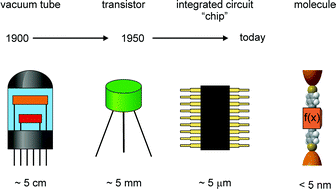Functional molecules in electronic circuits
Abstract
Molecular electronics is a fascinating field of research contributing to both fundamental science and future technological achievements. A promising starting point for molecular devices is to mimic existing electronic functions to investigate the potential of molecules to enrich and complement existing electronic strategies. Molecules designed and synthesized to be integrated into electronic circuits and to perform an electronic function are presented in this article. The focus is set in particular on rectification and switching based on molecular devices, since the control over these two parameters enables the assembly of memory units, likely the most interesting and economic application of molecular based electronics. Both historical and contemporary solutions to molecular rectification are discussed, although not exhaustively. Several examples of integrated molecular switches that respond to light are presented. Molecular switches responding to an electrochemical signal are also discussed. Finally, supramolecular and molecular systems with intuitive application potential as memory units due to their hysteretic switching are highlighted. Although a particularly attractive feature of molecular electronics is its close cooperation with neighbouring disciplines, this article is written from the point of view of a chemist. Although the focus here is largely on molecular considerations, innovative contributions from physics, electro engineering, nanotechnology and other scientific disciplines are equally important. However, the ability of the chemist to correlate function with structure, to design and to provide tailor-made functional molecules is central to molecular electronics.


 Please wait while we load your content...
Please wait while we load your content...